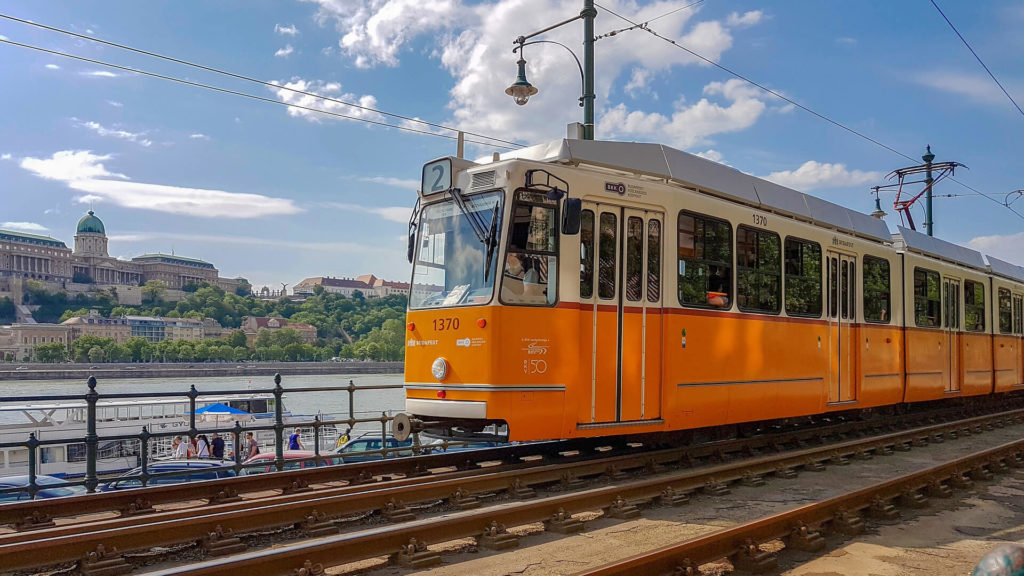Trams in Budapest

The Tram Lines in Budapest
Budapest’s tram network consists of over 40 tram lines that run throughout the city’s historic center. The following lines are the most useful for tourists:
Tram Line 2
Tram line 2 is one of the most popular tram lines in Budapest, providing great views over the Danube and Buda Hills. The tram runs along Pest’s Riverbank and passes by some of the city’s most iconic landmarks, including the Chain Bridge, the Hungarian Parliament, and the Central Market Hall. It runs from Kozvagohid to Jaszai Mari Square, which is the closest stop to Margaret Island.
Tram Lines 19 and 41V
Tram lines 19 and 41V travel along Buda’s riverside, offering similar views to tram line 2 but on the western part of the city. The lines link Batthyany ter (St. Anne’s Church) with Gellert Hill and are useful for tourists wanting to visit the Gellert Spa and the Citadella.
Tram Lines 4 and 6
Tram lines 4 and 6 are the busiest tram lines in Budapest, carrying the largest number of passengers in Europe. They are not as useful for tourists as they mainly serve residential areas.
Schedule and Tariffs
Trams in Budapest run from 4:30 am to 11 pm, with the most important lines running every 5 to 10 minutes. All of Budapest’s means of transport use the same tickets and travel passes and cost the same price:
- Single ticket: HUF 350
- Block of 10 tickets: HUF 3,000
- 24-hour travel card: HUF 1,650
- 72-hour travel card: HUF 4,150
Future Developments
Budapest’s tram network is constantly evolving, with several new developments in the pipeline. The Mayor of Budapest recently announced that 51 new CAF-type trams will arrive in the capital to run on the Buda lines, greatly helping the further development of public transport in Budapest.
There are also plans to reinstate the tram on one of the busiest streets, Thokoly Road, and link the rail axis. These plans are worth taking seriously and building as soon as domestic or EU funding can be secured, according to David Vitezy, a transport expert and former state secretary.
A Brief History of Trams in Budapest
The history of trams in Budapest dates back to the 19th century when the city was experiencing rapid growth and needed a reliable mode of public transportation. The first horse-drawn tram line was opened in 1866, and it was followed by the first electric tram line in 1887.
During the 1980s, Budapest’s tram network was in decline, and there were even proposals to close some of the lines. However, from the 2000s onwards, there were several developments that gave the network a new impetus. The arrival of the Combino trams in 2004-2006 and a contract with CAF, a Spanish railway vehicles manufacturing company, in 2014 marked a new era for Budapest’s tram system.
FAQs
How do I buy tickets for the tram?
Tickets for the tram can be purchased at ticket vending machines found at many tram stops, metro stations, and also at newsstands. Remember to validate your ticket once on board.
Can I travel with the same ticket on trams, buses, and the metro?
Yes, a standard ticket is valid for a single trip on all modes of public transportation within Budapest, including trams, buses, trolleys, and the metro.
What are the operating hours of the trams in Budapest?
Trams in Budapest generally operate from early morning until late at night. However, schedules vary depending on the route and the day of the week. Some lines offer 24-hour service.
How often do trams run in Budapest?
Tram frequency in Budapest varies depending on the route and time of day. During peak hours, trams can arrive as frequently as every 5 minutes.
What is the Budapest Card and can it be used on trams?
The Budapest Card is a travel card for tourists, which offers unlimited travel on public transportation, including trams, for a specified period of time (24, 48, 72, 96, or 120 hours). It also provides free or discounted access to many attractions.
What is the most scenic tram route in Budapest?
Many consider the No. 2 tram line as the most scenic route, as it travels along the Danube River, providing beautiful views of the Buda Castle, the Parliament, and other landmarks.

